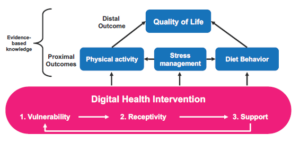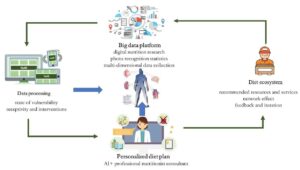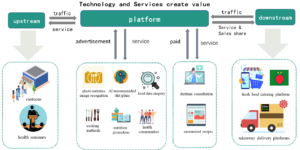Liyu Huang
Hopefully, with the ecosystem leaded by digital revolution, the health of people in China can be more sustainable. As the economy continues to grow, people are becoming aware of the importance of sustainable health. Digital revolution has led to an overall improvement in hardware equipment and software algorithms, which enables more and more people to prevent non-communicable diseases with digital monitoring and intervention. In China, because of the large number of populations and industries, a network effect of supply chains has been created for health ecosystem, especially for digital diet. However, there’s still challenges to optimize the ecosystem as well as raise awareness of digital health.
Monitor and Interventions
Meanwhile, there are five main ways of digital intervention for health improvement : Intermittent fasting, high-intensity interval training, sleep fitness, nutrient-rich diet and stress less[1] . With the wearable sensors, physiological status can be detected. Once there’s a symptom shows vulnerability, which means nearly becoming sub-healthy, then the software on mobile phone will give intervention information, and also give advice for support [2].
88......1 – 
Figure 1: Digital Health Intervention Process (Kowastch, 2020)
Normal monitor indicators include blood pressure and heartbeat, and with the introduction of high technology, facial recognition, behavioral recognition and even odor recognition have also been introduced to detect all aspects of a person’s physiological state [3]. Here, we emphasize on an specific example of the input data from digital diet health (foodie APP, data supplier of Meituan). It is widely seen that people enjoy taking pictures of delicious food to communicate with friends or to upload on social media, and some people in China may even spend a lot time to photoshop, which has formed a trend. Therefore, innovation takes place on the collection procedure of health data (diet) photo recognition. At this point, AI could provide them with a picture beautification service as part of the data collection process (similar to Airbnb providing photo-taking service). Clients may take it as a data transaction or value-added service, thus will be more willing to take pictures, which benefits the monitor process a lot. What’s more, diet ingredients can also be identified with data from the client’s previous medical history (like nutritional deficiencies or excesses) [4]or local address information (to judge which restaurant) and also match successful intervention cases from other patients in similar situations, and then the digital platform can give timely feedback and advice [5]. The AI can automatically draw up a patient profile based on big data and serve with appropriate dietary education and online counselling.

Figure 2: AI photo recognition of food and ingredients (Huagang Wen,2019)
The monitor process and methods enjoy a disruptive innovation with digital revolution.
The digital health-diet ecosystems
Unlike other Digital Health Interventions (DHIs), related industry in China is outdoor offline and can be combined with mature logistics, catering and other physical industries to form a complete ecosystem [6]. In China, digital health platforms (leaded by Meituan) start from upstream to get traffic. Serving business side users such as large canteens or health seminars, and then promote from point to point to precisely classify users from customer side.

Figure 3: Meituan business model and strategy (Meituan,2019)
Technologies and service are the main part to create value. For the free service, huge customer traffic is used to achieve hidden revenue for advertisements to health-related industries, and also obtain data on clients’ diets, health, and even living habits to enrich database. This will not only improve the professionalism of the platform’s big data analysis and recommendation algorithms, but can also supply data to doctors or pharmaceutical companies for research and development. That is a kind of positive circulation.
Free services are taken us public welfare, including image recognition and also hierarchical health services. For example, for users with low education level, the platforms provide AI-suggested diet plans and nutritional enhancement advice; for customers with high education but low nutritional expertise, they provide food data queries and science education, and for clients with high expertise, they provide scientific papers from a principled perspective. Therefore, various intervention methods can match all different groups of people.
Of course, public service and entertainments are also indispensable. In China, it can form spectacular net-work effect. Sustainable diet is not only about the food ingredients, but also about cooking methods. With digital revolution, customers can be given advice on detailed steps and they can even record videos for AI analysis. What’s more, social aspect such as health communities is established virtually to attract active customers, and also most indirect data or information can be collected through interactions. It’s a place for users to show and record own diet habits, communicate with each other and find like-minded people. Daily active uses of the platform (Dianping lead by Meituan) have now accumulated substantially with interesting health communities [7].
The paid services involve customized personal services, such as long-term systematic dietary advice, or short-term recipes and all enquiries about sustainable dietary knowledge (ingredients, cooking), it’s a high-level service in which digital health is a traffic provider for nutritionists and doctors.
The final but most important link in China’s digital diet ecosystem is the downstream resources. Fresh ingredients, semi-finished food, restaurants, takeaway platforms and logistics services, form the closed loop of our entire ecosystem. For example, once the nutritional status assessment is completed, the type and amount of nutrients to be consumed for a diet is determined, recommendations can be made for a variety of choices for nearby food based on timely location and dietary preferences. The innovation by digital revolution in this part is the link between resources: supply chain no longer sticks to restaurants, but focus on the dishes. Through data collaboration and standardization, the system can combine some of the dishes from different restaurants into customized buddle, with logistics management, making each restaurant part of the digital supply chain of the ecosystem.

Figure 4: Ecosystem developed by Meituan (Yuting Shang,2021)
Challenges and Outlook
Despite the fact that hardware sensors, software feedback interventions, and suggested information content is accurate, people have not yet developed a sense of using digital revolution to achieve sustainable health. There is an old Chinese saying that “food is the key to life”, so digital diets are successfully widely practiced in China, but other modes like sleep fitness, intermittent fasting and high-intensity interval training are not yet widespread. With the help of digital revolution, it might wake people’s mind to prevent chronic diseases.
In addition, it is quite good that digital health companies are now supplying clients’ data to doctors and pharmaceutical companies, using enriched big data to support scientific research and development, but there is also a need to focus on data security and personal privacy.
Hopefully, with the ecosystem leaded by digital revolution, our health can be more sustainable!
References:(please use APA style, BW)
[1] Fischer, J. E., Greenhalgh, C., & Benford, S. (2011). Investigating episodes of mobile phone activity as indicators of opportune moments to deliver notifications. Paper presented at the 13th International Conference on Human Computer Interaction with Mobile Devices and Services (MobileHCI ’11), Stockholm, Sweden.
[2] Harari, G. M., Gosling, S. D., Wang, R., & Campbell, A. T. (2015). Capturing Situational Information with Smartphones and Mobile Sensing Methods. European Journal of Personality, 29(5), 509-511.
[3] Turner, L. D., Allen, S. M., & Whitaker, R. M. (2017). Reachable but not receptive: Enhancing smartphone interruptibility prediction by modelling the extent of user engagement with notifications. Pervasive and Mobile Computing, 40(September), 480-494.
[4] Nahum-Shani, I., Hekler, E. B., & Spruijt-Metz, D. (2015). Building Health Behavior Models to Guide the Development of Just-in-Time Adaptive Interventions: A Pragmatic Framework. Health Psychology, 34(Supplement), 1209-1219.
[5] Nahum-Shani I., Spruijt-Metz D., Hekler E. Building Health Behavior Models to Guide the Development of Just-in-Time Adaptive Interventions: A Pragmatic Framework. Health Psychology, 2015
[6] 戴勇,王元芳. 生活服务电商平台的生态系统演化——战略逻辑和生命周期视角[J]. 湖北工业大学学报,2021,36(03):5-9.
[7] 祁大伟,宋立丰,魏巍. 互联网独角兽企业生态圈与数字经济环境的双向影响机制——基于滴滴和美团的案例分析[J]. 中国流通经济,2021,35(02):84-99.
